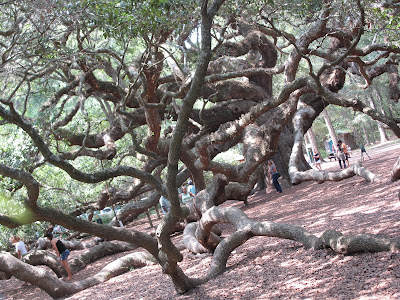Wednesday, July 4, 2012
The Angel Oak
Species name: Quercus virginiana
Common name: live oak, southern live oak
Location: South Carolina; photo #1 from HERE, photo #s 2-4 from HERE
Since today is Independence Day in the United States, I figured that, like for Canada Day, I would profile the national tree of the US for today's blog. Unfortunately, I don't have any other spectacular pictures of oak trees other than the ones I've already posted so I had to resort to the internet. I have heard of this rather iconic tree in Charleston, South Carolina and after seeing the photos of this tree I really want to go see it in person! It's called the Angel Oak, and (thankfully) it's a native species of oak to the southeastern US called the live oak or southern live oak (since the common name "live oak" applies to many species of oak in North America, South America and Europe). This species is also iconic to the southern United States, being the tree of choice to line roadways in Georgia, Louisiana, South Carolina, and Florida. It is an evergreen tree in most areas of its range (the further north the more likely the tree is to lose its leaves in the fall, and the further south the more likely the tree is to lose its leaves during the driest months in the summer) with dark green, glossy leaves that look nothing like what you would typically think of as an oak leaf. They have almost a smooth border with no lobes, and look very much like a leaflet of a willow tree; long and quite narrow. They do form the characteristic acorn of the Quercus genus, so that should give away that it's an oak at first glance.
The Angel Oak is a single tree that is estimated to be between 350 and 400 years old, so it was an adolescent (as far as "tree years" go) when the United States gained their independence from Great Britain in 1776. Despite providing shade for almost 17,000 square feet of parkland, it's only about 65 feet tall! One of the defining characteristics of the southern live oak is it's short stature compared to its outward growth (the longest limb of the Angel Oak is 105 feet long).
How this tree obtained its common name is up for debate, and which story you believe has more to do with folklore and if you believe in ghosts than anything else. It has been said that the oak is growing on the former Angel estate, but the borders of that estate land have been recently disputed, and the border of the estate may or may not include the tree. The other story behind the name is that the Angel family heavily employed slave labor on their farm and now the ghosts of the slaves gather around the tree. Regardless of how the tree got its name, it has become one of the most popular tourist attractions in Charleston. Not bad for a tree!
Happy Independence Day to all my American readers!
Subscribe to:
Post Comments (Atom)





.svg.png)
No comments:
Post a Comment